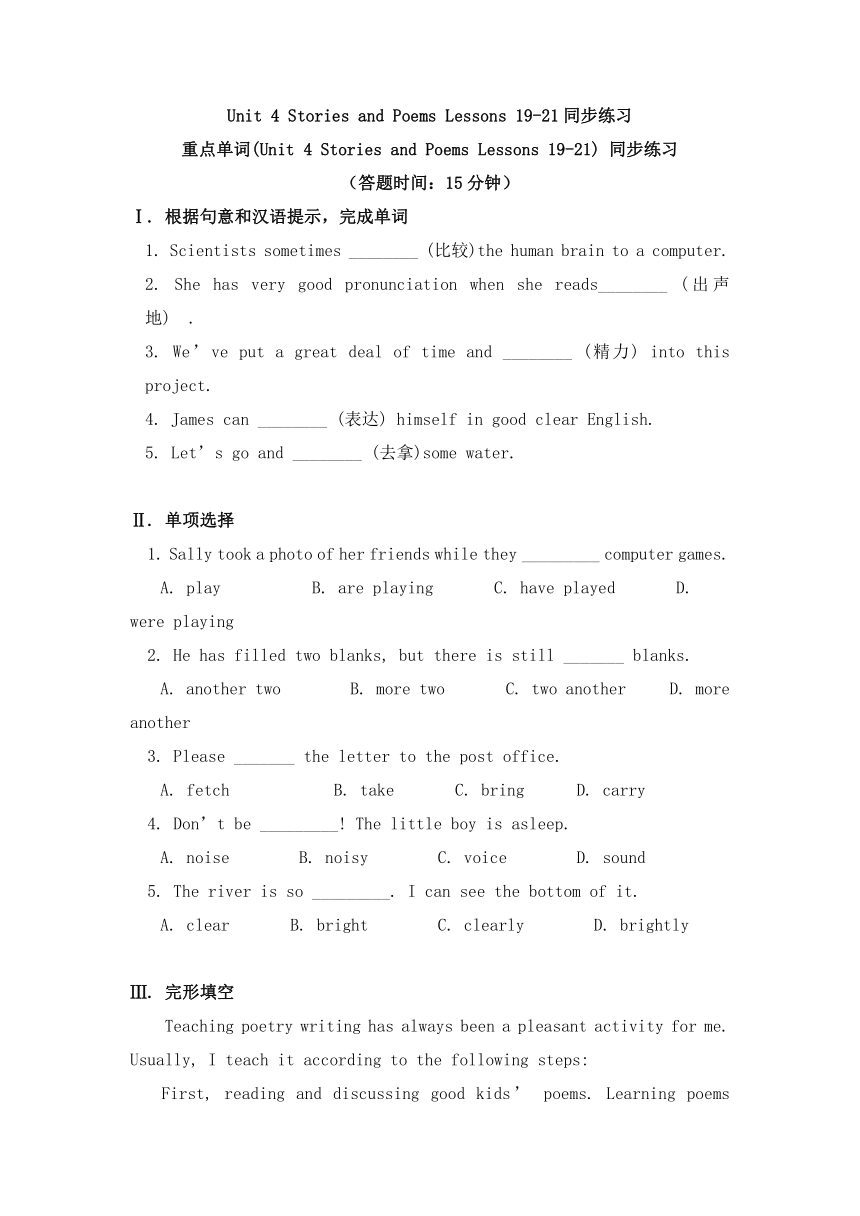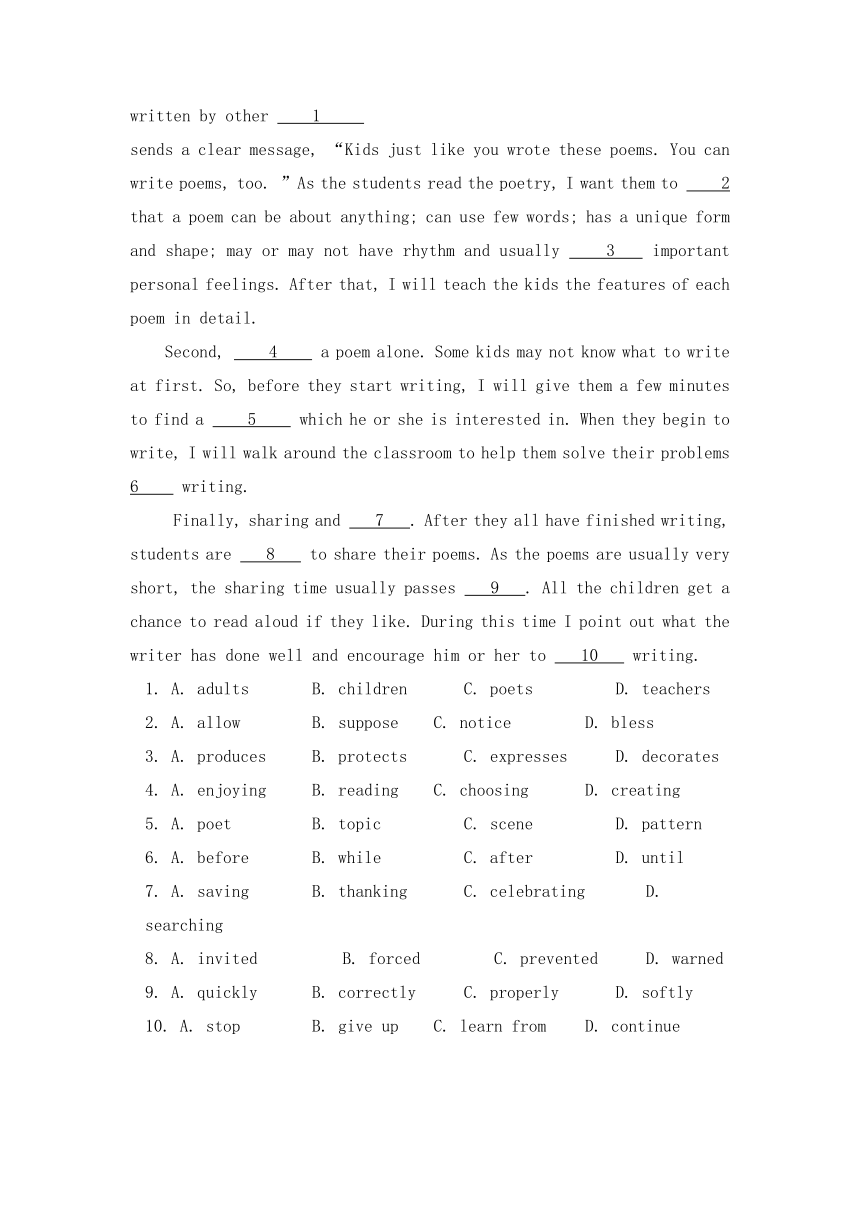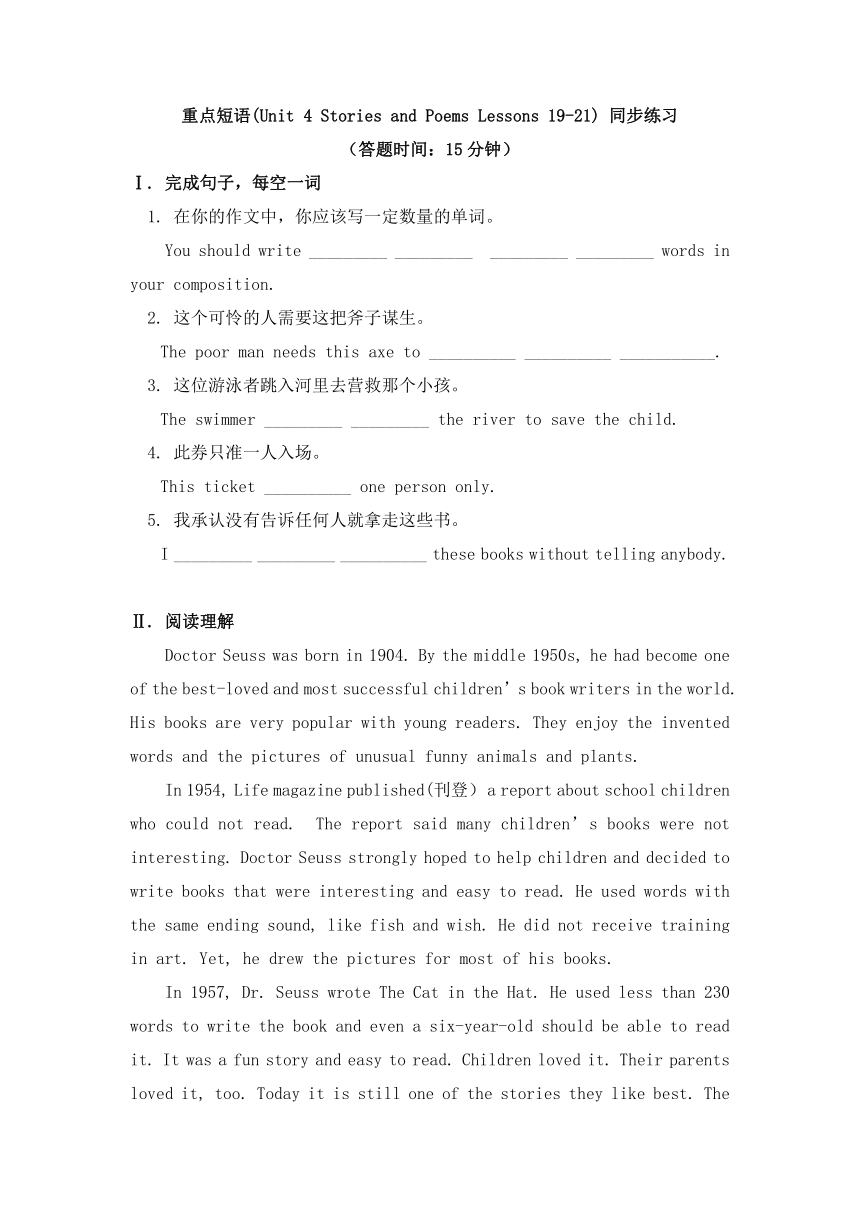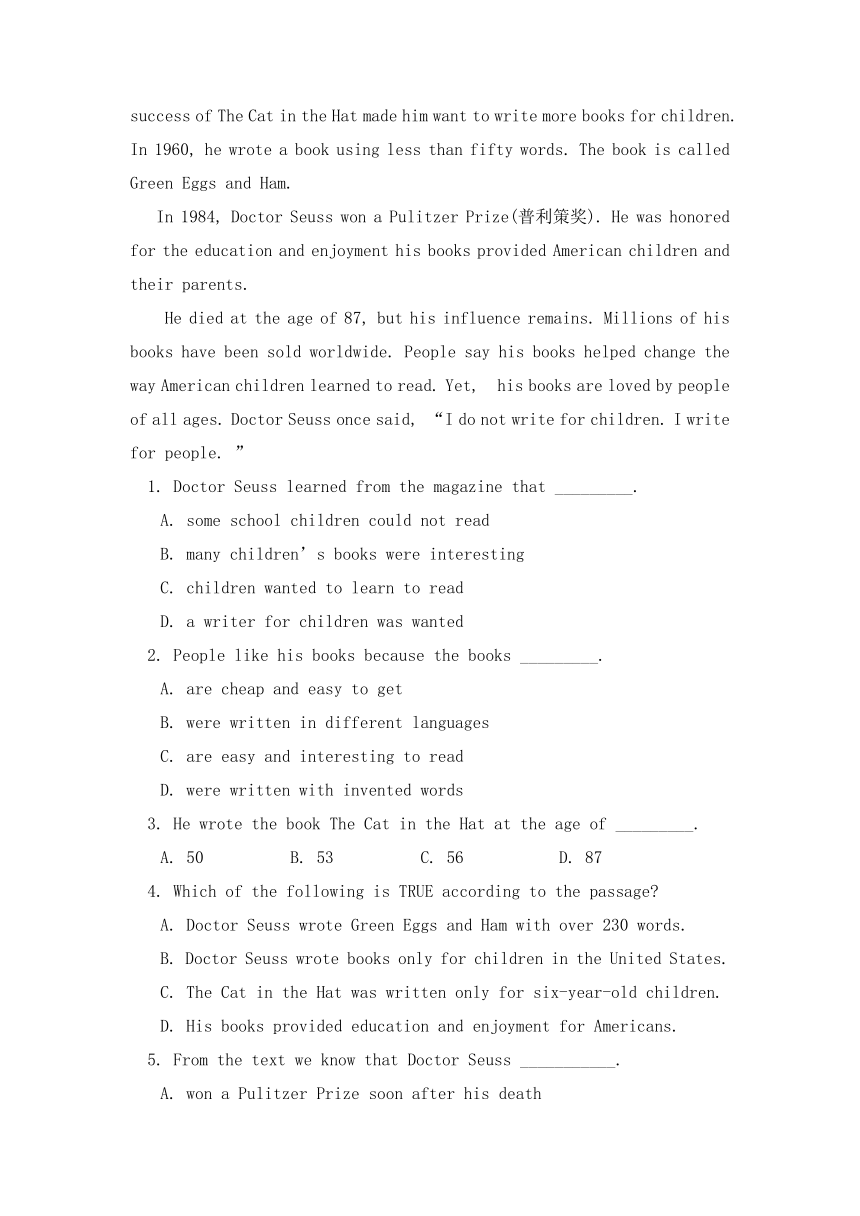英语九年级上册Unit 4 Stories and Poems Lessons 19-21同步练习-冀教版
文档属性
| 名称 | 英语九年级上册Unit 4 Stories and Poems Lessons 19-21同步练习-冀教版 |

|
|
| 格式 | doc | ||
| 文件大小 | 70.1KB | ||
| 资源类型 | 教案 | ||
| 版本资源 | 冀教版 | ||
| 科目 | 英语 | ||
| 更新时间 | 2020-09-10 18:12:23 | ||
图片预览





文档简介
Unit 4 Stories and Poems Lessons 19-21同步练习
重点单词(Unit 4 Stories and Poems Lessons 19-21) 同步练习
(答题时间:15分钟)
Ⅰ. 根据句意和汉语提示,完成单词
1. Scientists sometimes ________ (比较)the human brain to a computer.
2. She has very good pronunciation when she reads________ (出声地)?. ?
3. We’ve put a great deal of time and ________ (精力) into this project.??
4. James can ________ (表达) himself in good clear English.
5. Let’s go and ________ (去拿)some water.
Ⅱ. 单项选择
1. Sally took a photo of her friends while they _________ computer games.
A. play B. are playing C. have played D. were playing
2. He has filled two blanks, but there is still _______ blanks.
A. another two? B. more two? C. two another D. more another
3. Please _______ the letter to the post office.
A. fetch?? ?B. take C. bring D. carry
4. Don’t be _________! The little boy is asleep.
A. noise B. noisy C. voice D. sound
5. The river is so _________. I can see the bottom of it.
A. clear B. bright C. clearly D. brightly
Ⅲ. 完形填空
Teaching poetry writing has always been a pleasant activity for me. Usually, I teach it according to the following steps:
First, reading and discussing good kids’ poems. Learning poems written by other 1
sends a clear message, “Kids just like you wrote these poems. You can write poems, too. ”As the students read the poetry, I want them to 2 that a poem can be about anything; can use few words; has a unique form and shape; may or may not have rhythm and usually 3 important personal feelings. After that, I will teach the kids the features of each poem in detail.
Second, 4 a poem alone. Some kids may not know what to write at first. So, before they start writing, I will give them a few minutes to find a 5 which he or she is interested in. When they begin to write, I will walk around the classroom to help them solve their problems 6 writing.
Finally, sharing and 7 . After they all have finished writing, students are 8 to share their poems. As the poems are usually very short, the sharing time usually passes 9 . All the children get a chance to read aloud if they like. During this time I point out what the writer has done well and encourage him or her to 10 writing.
1. A. adults B. children C. poets D. teachers
2. A. allow B. suppose C. notice D. bless
3. A. produces B. protects C. expresses D. decorates
4. A. enjoying B. reading C. choosing D. creating
5. A. poet B. topic C. scene D. pattern
6. A. before B. while C. after D. until
7. A. saving B. thanking C. celebrating D. searching
8. A. invited B. forced C. prevented D. warned
9. A. quickly B. correctly C. properly D. softly
10. A. stop B. give up C. learn from D. continue
重点短语(Unit 4 Stories and Poems Lessons 19-21) 同步练习
(答题时间:15分钟)
Ⅰ. 完成句子,每空一词
1. 在你的作文中,你应该写一定数量的单词。
You should write _________ _________?_________ _________ words in your composition.
2. 这个可怜的人需要这把斧子谋生。
The poor man needs this axe to __________ __________ ___________.
3. 这位游泳者跳入河里去营救那个小孩。
The swimmer _________ _________ the river to save the child.
4. 此券只准一人入场。
This ticket __________ one person only.
5. 我承认没有告诉任何人就拿走这些书。
I _________ _________ __________ these books without telling anybody.
Ⅱ. 阅读理解
Doctor Seuss was born in 1904. By the middle 1950s, he had become one of the best-loved and most successful children’s book writers in the world. His books are very popular with young readers. They enjoy the invented words and the pictures of unusual funny animals and plants.
In 1954, Life magazine published(刊登) a report about school children who could not read. The report said many children’s books were not interesting. Doctor Seuss strongly hoped to help children and decided to write books that were interesting and easy to read. He used words with the same ending sound, like fish and wish. He did not receive training in art. Yet, he drew the pictures for most of his books.
In 1957, Dr. Seuss wrote The Cat in the Hat. He used less than 230 words to write the book and even a six-year-old should be able to read it. It was a fun story and easy to read. Children loved it. Their parents loved it, too. Today it is still one of the stories they like best. The success of The Cat in the Hat made him want to write more books for children. In 1960, he wrote a book using less than fifty words. The book is called Green Eggs and Ham.
In 1984, Doctor Seuss won a Pulitzer Prize(普利策奖). He was honored for the education and enjoyment his books provided American children and their parents.
He died at the age of 87, but his influence remains. Millions of his books have been sold worldwide. People say his books helped change the way American children learned to read. Yet, his books are loved by people of all ages. Doctor Seuss once said, “I do not write for children. I write for people. ”
1. Doctor Seuss learned from the magazine that _________.
A. some school children could not read
B. many children’s books were interesting
C. children wanted to learn to read
D. a writer for children was wanted
2. People like his books because the books _________.
A. are cheap and easy to get
B. were written in different languages
C. are easy and interesting to read
D. were written with invented words
3. He wrote the book The Cat in the Hat at the age of _________.
A. 50 B. 53 C. 56 D. 87
4. Which of the following is TRUE according to the passage?
A. Doctor Seuss wrote Green Eggs and Ham with over 230 words.
B. Doctor Seuss wrote books only for children in the United States.
C. The Cat in the Hat was written only for six-year-old children.
D. His books provided education and enjoyment for Americans.
5. From the text we know that Doctor Seuss ___________.
A. won a Pulitzer Prize soon after his death
B. sold millions of his books himself worldwide
C. changed American children’s way of reading
D. wrote the largest number of books in the world
重点句型(Unit 4 Stories and Poems Lessons 19-21) 同步练习
(答题时间:20分钟)
Ⅰ. 根据要求完成句子,每空一词
1. Must I give you the money? (做否定回答)
No, ________ ________.
2. It takes too much time to write a story. (改为一般疑问句)
_________ _________ ________ too much time to write a story?
3. Let’s look at two more poems as examples. (改为同义句)
Let’s look at ________ ________ poems as examples.
4. Although my bike is very new, I still want to buy a new one. (改为同义句)
My bike is very new, __________ I still want to buy a new one.
5. My uncle compared his camera with mine. (对划线部分提问)
________ ________ your uncle __________ with mine?
Ⅱ. 书面表达
这周李明在学校里学习了怎样写诗和故事,有的同学认为诗短小、不用花费很长时间,所以更容易写,有的学生认为故事虽然很长,但是不用考虑格式和韵脚,假如你是李明,请结合大家的观点写一篇80词左右的作文。同时,别忘了发表一下自己的看法。
要求:1. 词数:80左右。
2. 字迹工整、语言流畅、表达正确、逻辑清晰。
3. 可适当拓展。
____________________________________________________________________________________________________________________________________________________________________________________________________________________________________________________________________________________________________________________________________________________________________________________________________________________________________________________________________________________________________________________________________________________________________.
Unit 4 Stories and Poems Lessons 19-21同步练习参考答案
重点单词(Unit 4 Stories and Poems Lessons 19-21) 同步练习参考答案
Ⅰ. 1. compare 2. aloud 3. effort 4. express 5. fetch
Ⅱ. 1. D 句意“当她们正在玩游戏时Sally拍了她朋友的一张照片”根据前一句took,可以确定后面横线上用过去进行时。
2. A 句意“他已经填完了两个空。但是还有两个空。”表示再有几个,另外的几个用数字+more或another+数字。
3. B 句意“请把这封信送到邮局去。”take表示将某物从说话地带到其他地方去。
4. B 四个选项分别意为“噪音”、“吵闹的”、“嗓音”、“声音”,结合关键信息“The little boy is asleep. ”可知是“别吵闹了”。
5. A 根据题意“河水是如此清澈,我能看到河的底部。”可知应用形容词,故应排除C、D两项。clear意为“清澈的”;bright意为“明亮的”。
Ⅲ. 1. B 解析:由前句中kids可知是“孩子们”,learning poems written by other children意为“学习由别的孩子作的诗”。
2. C 解析:四个选项都是动词,由题意“让他们注意到……”可知正确答案为C。
3. C 解析:由题意“通常表达重要的个人情感”可排除A、B、D三项,选C。express意为“表达”。
4. D 解析:由下文“So, before they start writing”可知让学生“创作诗”,故选D。
5. B 解析:由上下文可知,写诗前要先选一个主题。故选B。
6. B 解析:根据题意“当他们开始写时,我会在教室里巡回来帮助他们解决问题”可知填while,表示“当……的时候”。
7. C 解析:由上下文可知写完后要分享和庆祝。
8. A 解析:根据题意“孩子们被邀请来分享他们的诗歌”可排除B、C、D三项,选A。
9. A 解析:由上句中的“As the poems are usually very short”可知诗很短,时间过得快。故选A。
10. D 解析:由句意“这时我指出作者哪方面写得好而且鼓励他或她继续写下去。”可知选D。
重点短语(Unit 4 Stories and Poems Lessons 19-21) 同步练习参考答案
Ⅰ. 1. a set number of 2. make a /his living 3.dived into 4. admits 5. admit to taking
Ⅱ. 1. A 解析:根据第二段中的“a report about school children who could not read. ”可知选A。
2. C 解析:根据短文中的“that were interesting and easy to read”可知他的书有趣易懂。
3. B 解析:由第三段第一句可知,他在1957年写这本书,并且由文章第一句可知,他出生于1904年,因此答案为53岁。
4. D 解析:根据He was honored for the education and enjoyment his books provided American children and their parents.可知他的书给美国人提供了教育和娱乐。
5. C 解析:根据最后一段的第三句话“People say his books helped change the way American children learned to read. ”可知选C。
重点句型(Unit 4 Stories and Poems Lessons 19-21) 同步练习参考答案
Ⅰ. 1. you needn’t 2. Does it take 3. another two 4. but 5. What did, compare
Ⅱ. One possible version:
This week, we learnt how to write poems and stories in our class. Some students think it’s easy to write a poem. Because poems are always short. Writing a poem takes less time than writing a story. Others think it’s easier to write a story. Although a story usually has a longer passage, it doesn’t limit you like a poem does. You needn’t to think about format and rhyme. I think although a poem has fewer words, it’s not easier to write. Every word must have power and meaning. It may take a long time to come up with the right words.
重点单词(Unit 4 Stories and Poems Lessons 19-21) 同步练习
(答题时间:15分钟)
Ⅰ. 根据句意和汉语提示,完成单词
1. Scientists sometimes ________ (比较)the human brain to a computer.
2. She has very good pronunciation when she reads________ (出声地)?. ?
3. We’ve put a great deal of time and ________ (精力) into this project.??
4. James can ________ (表达) himself in good clear English.
5. Let’s go and ________ (去拿)some water.
Ⅱ. 单项选择
1. Sally took a photo of her friends while they _________ computer games.
A. play B. are playing C. have played D. were playing
2. He has filled two blanks, but there is still _______ blanks.
A. another two? B. more two? C. two another D. more another
3. Please _______ the letter to the post office.
A. fetch?? ?B. take C. bring D. carry
4. Don’t be _________! The little boy is asleep.
A. noise B. noisy C. voice D. sound
5. The river is so _________. I can see the bottom of it.
A. clear B. bright C. clearly D. brightly
Ⅲ. 完形填空
Teaching poetry writing has always been a pleasant activity for me. Usually, I teach it according to the following steps:
First, reading and discussing good kids’ poems. Learning poems written by other 1
sends a clear message, “Kids just like you wrote these poems. You can write poems, too. ”As the students read the poetry, I want them to 2 that a poem can be about anything; can use few words; has a unique form and shape; may or may not have rhythm and usually 3 important personal feelings. After that, I will teach the kids the features of each poem in detail.
Second, 4 a poem alone. Some kids may not know what to write at first. So, before they start writing, I will give them a few minutes to find a 5 which he or she is interested in. When they begin to write, I will walk around the classroom to help them solve their problems 6 writing.
Finally, sharing and 7 . After they all have finished writing, students are 8 to share their poems. As the poems are usually very short, the sharing time usually passes 9 . All the children get a chance to read aloud if they like. During this time I point out what the writer has done well and encourage him or her to 10 writing.
1. A. adults B. children C. poets D. teachers
2. A. allow B. suppose C. notice D. bless
3. A. produces B. protects C. expresses D. decorates
4. A. enjoying B. reading C. choosing D. creating
5. A. poet B. topic C. scene D. pattern
6. A. before B. while C. after D. until
7. A. saving B. thanking C. celebrating D. searching
8. A. invited B. forced C. prevented D. warned
9. A. quickly B. correctly C. properly D. softly
10. A. stop B. give up C. learn from D. continue
重点短语(Unit 4 Stories and Poems Lessons 19-21) 同步练习
(答题时间:15分钟)
Ⅰ. 完成句子,每空一词
1. 在你的作文中,你应该写一定数量的单词。
You should write _________ _________?_________ _________ words in your composition.
2. 这个可怜的人需要这把斧子谋生。
The poor man needs this axe to __________ __________ ___________.
3. 这位游泳者跳入河里去营救那个小孩。
The swimmer _________ _________ the river to save the child.
4. 此券只准一人入场。
This ticket __________ one person only.
5. 我承认没有告诉任何人就拿走这些书。
I _________ _________ __________ these books without telling anybody.
Ⅱ. 阅读理解
Doctor Seuss was born in 1904. By the middle 1950s, he had become one of the best-loved and most successful children’s book writers in the world. His books are very popular with young readers. They enjoy the invented words and the pictures of unusual funny animals and plants.
In 1954, Life magazine published(刊登) a report about school children who could not read. The report said many children’s books were not interesting. Doctor Seuss strongly hoped to help children and decided to write books that were interesting and easy to read. He used words with the same ending sound, like fish and wish. He did not receive training in art. Yet, he drew the pictures for most of his books.
In 1957, Dr. Seuss wrote The Cat in the Hat. He used less than 230 words to write the book and even a six-year-old should be able to read it. It was a fun story and easy to read. Children loved it. Their parents loved it, too. Today it is still one of the stories they like best. The success of The Cat in the Hat made him want to write more books for children. In 1960, he wrote a book using less than fifty words. The book is called Green Eggs and Ham.
In 1984, Doctor Seuss won a Pulitzer Prize(普利策奖). He was honored for the education and enjoyment his books provided American children and their parents.
He died at the age of 87, but his influence remains. Millions of his books have been sold worldwide. People say his books helped change the way American children learned to read. Yet, his books are loved by people of all ages. Doctor Seuss once said, “I do not write for children. I write for people. ”
1. Doctor Seuss learned from the magazine that _________.
A. some school children could not read
B. many children’s books were interesting
C. children wanted to learn to read
D. a writer for children was wanted
2. People like his books because the books _________.
A. are cheap and easy to get
B. were written in different languages
C. are easy and interesting to read
D. were written with invented words
3. He wrote the book The Cat in the Hat at the age of _________.
A. 50 B. 53 C. 56 D. 87
4. Which of the following is TRUE according to the passage?
A. Doctor Seuss wrote Green Eggs and Ham with over 230 words.
B. Doctor Seuss wrote books only for children in the United States.
C. The Cat in the Hat was written only for six-year-old children.
D. His books provided education and enjoyment for Americans.
5. From the text we know that Doctor Seuss ___________.
A. won a Pulitzer Prize soon after his death
B. sold millions of his books himself worldwide
C. changed American children’s way of reading
D. wrote the largest number of books in the world
重点句型(Unit 4 Stories and Poems Lessons 19-21) 同步练习
(答题时间:20分钟)
Ⅰ. 根据要求完成句子,每空一词
1. Must I give you the money? (做否定回答)
No, ________ ________.
2. It takes too much time to write a story. (改为一般疑问句)
_________ _________ ________ too much time to write a story?
3. Let’s look at two more poems as examples. (改为同义句)
Let’s look at ________ ________ poems as examples.
4. Although my bike is very new, I still want to buy a new one. (改为同义句)
My bike is very new, __________ I still want to buy a new one.
5. My uncle compared his camera with mine. (对划线部分提问)
________ ________ your uncle __________ with mine?
Ⅱ. 书面表达
这周李明在学校里学习了怎样写诗和故事,有的同学认为诗短小、不用花费很长时间,所以更容易写,有的学生认为故事虽然很长,但是不用考虑格式和韵脚,假如你是李明,请结合大家的观点写一篇80词左右的作文。同时,别忘了发表一下自己的看法。
要求:1. 词数:80左右。
2. 字迹工整、语言流畅、表达正确、逻辑清晰。
3. 可适当拓展。
____________________________________________________________________________________________________________________________________________________________________________________________________________________________________________________________________________________________________________________________________________________________________________________________________________________________________________________________________________________________________________________________________________________________________.
Unit 4 Stories and Poems Lessons 19-21同步练习参考答案
重点单词(Unit 4 Stories and Poems Lessons 19-21) 同步练习参考答案
Ⅰ. 1. compare 2. aloud 3. effort 4. express 5. fetch
Ⅱ. 1. D 句意“当她们正在玩游戏时Sally拍了她朋友的一张照片”根据前一句took,可以确定后面横线上用过去进行时。
2. A 句意“他已经填完了两个空。但是还有两个空。”表示再有几个,另外的几个用数字+more或another+数字。
3. B 句意“请把这封信送到邮局去。”take表示将某物从说话地带到其他地方去。
4. B 四个选项分别意为“噪音”、“吵闹的”、“嗓音”、“声音”,结合关键信息“The little boy is asleep. ”可知是“别吵闹了”。
5. A 根据题意“河水是如此清澈,我能看到河的底部。”可知应用形容词,故应排除C、D两项。clear意为“清澈的”;bright意为“明亮的”。
Ⅲ. 1. B 解析:由前句中kids可知是“孩子们”,learning poems written by other children意为“学习由别的孩子作的诗”。
2. C 解析:四个选项都是动词,由题意“让他们注意到……”可知正确答案为C。
3. C 解析:由题意“通常表达重要的个人情感”可排除A、B、D三项,选C。express意为“表达”。
4. D 解析:由下文“So, before they start writing”可知让学生“创作诗”,故选D。
5. B 解析:由上下文可知,写诗前要先选一个主题。故选B。
6. B 解析:根据题意“当他们开始写时,我会在教室里巡回来帮助他们解决问题”可知填while,表示“当……的时候”。
7. C 解析:由上下文可知写完后要分享和庆祝。
8. A 解析:根据题意“孩子们被邀请来分享他们的诗歌”可排除B、C、D三项,选A。
9. A 解析:由上句中的“As the poems are usually very short”可知诗很短,时间过得快。故选A。
10. D 解析:由句意“这时我指出作者哪方面写得好而且鼓励他或她继续写下去。”可知选D。
重点短语(Unit 4 Stories and Poems Lessons 19-21) 同步练习参考答案
Ⅰ. 1. a set number of 2. make a /his living 3.dived into 4. admits 5. admit to taking
Ⅱ. 1. A 解析:根据第二段中的“a report about school children who could not read. ”可知选A。
2. C 解析:根据短文中的“that were interesting and easy to read”可知他的书有趣易懂。
3. B 解析:由第三段第一句可知,他在1957年写这本书,并且由文章第一句可知,他出生于1904年,因此答案为53岁。
4. D 解析:根据He was honored for the education and enjoyment his books provided American children and their parents.可知他的书给美国人提供了教育和娱乐。
5. C 解析:根据最后一段的第三句话“People say his books helped change the way American children learned to read. ”可知选C。
重点句型(Unit 4 Stories and Poems Lessons 19-21) 同步练习参考答案
Ⅰ. 1. you needn’t 2. Does it take 3. another two 4. but 5. What did, compare
Ⅱ. One possible version:
This week, we learnt how to write poems and stories in our class. Some students think it’s easy to write a poem. Because poems are always short. Writing a poem takes less time than writing a story. Others think it’s easier to write a story. Although a story usually has a longer passage, it doesn’t limit you like a poem does. You needn’t to think about format and rhyme. I think although a poem has fewer words, it’s not easier to write. Every word must have power and meaning. It may take a long time to come up with the right words.
同课章节目录
- Unit 1 Stay Healthy
- Lesson 1 What's Wrong,Danny?
- Lesson 2 A Visit to the Dentist
- Lesson 3 Good Food, Good Health
- Lesson 4 Don't Smoke, Please!
- Lesson 5 Jane's Lucky Life
- Lesson 6 Stay Away from the Hospital
- Unit Review
- Unit 2 Great People
- Lesson 7 What Is the Meaning of Lift?
- Lesson 8 A Universe of Thought
- Lesson 9 China's Most Famous "Farmer"
- Lesson 10 Touch the World
- Lesson 11 To China, with Love
- Lesson 12 Guess My Hero!
- Unit Review
- Unit 3 Safety
- Lesson 13 Be Careful,Danny!
- Lesson 14 Accidents Happen
- Lesson 15 My Helmet Saved My Life!
- Lesson 16 How Safe Is Your Home?
- Lesson 17 Staying Safe in an Earthquake
- Lesson 18 Never Catch a Dinosaur
- Unit Review
- Unit 4 Stories and poems
- Lesson 19 A Story or a Poem?
- Lesson 20 Say It in Five
- Lesson 21 The Fable of the Woodcutte
- Lesson 22 The Giant(Ⅰ)
- Lesson 23 The Giant(Ⅱ)
- Lesson 24 Writing a Poem
- Unit Review
- Unit 5 Look into Science
- Lesson 25 Let's Do an Experiment!
- Lesson 26 Keep the Candle Burning
- Lesson 27 Planet Danny
- Lesson 28 The Study of Living Things
- Lesson 29 DNA—The Story of You
- Lesson 30 Science Affects Us
- Unit Review
- Unit 6 Movies and Theate
- Lesson 31 A movie or a Play
- Lesson 32 Moving Pictures
- Lesson 33 The Fisherman and the Goldfish(Ⅰ)
- Lesson 34 The Fisherman and the Goldfish(Ⅱ)
- Lesson 35 Theatres Are Fun!
- Lesson 36 Making Plays Is Fun
- Unit Review
